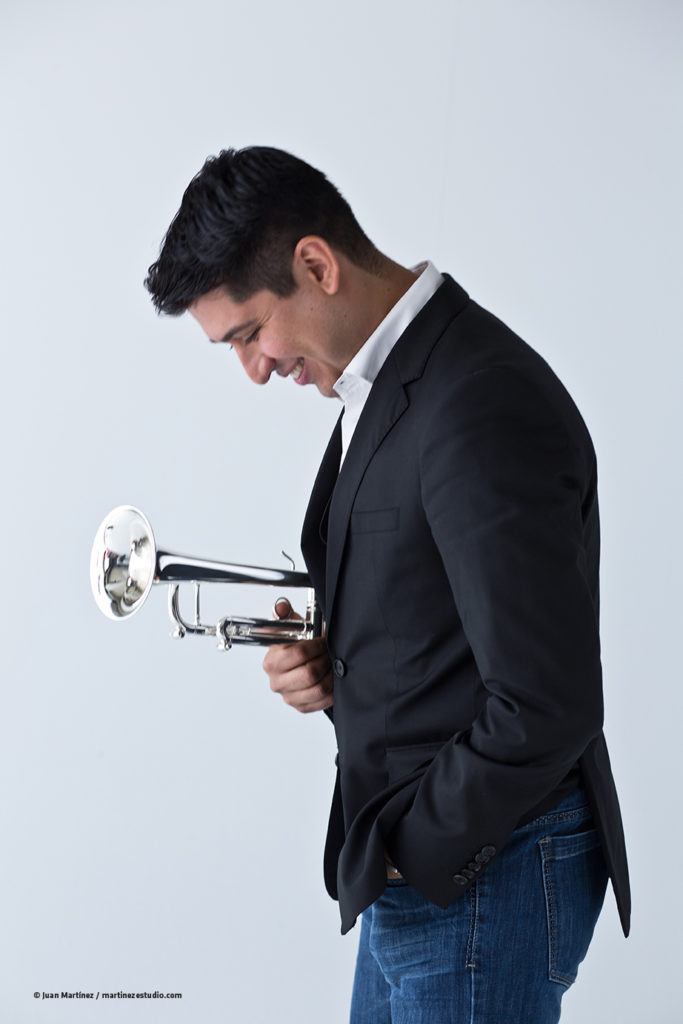San Diego Symphony Champions Bernstein’s ‘Symphonic Dances’ and Roberto Sierra’s Recent Trumpet Concerto
In her enthusiastic welcome to Friday’s Opening Night concert of the San Diego Symphony’s summer season at the Rady Shell, C.E.O. Martha A. Gilmer observed the members of the substantial audience enjoying the balmy weather. “It’s so much better than seeing you wrapped up in blankets,” she quipped, alluding to those very chilly May grey nights we endured as the Jacobs Masterworks Season came to a close.
And the atmosphere warmed up even more as Music Director Rafael Payare and the orchestra launched into Leonard Bernstein’s “Symphonic Dances from West Side Story.” Although the “Symphonic Dances” presents one of the musical’s familiar songs—“Somewhere”—this is no cheerful medley of the score’s many hit tunes. Rather, the “Symphonic Dances” marches through the catalogue of the musical’s dramatic moments, revealing Bernstein’s skillful orchestrations and abundant, inventive themes.Among the many virtues of this performance, allow me to cite guest saxophone Mark Shannon for his dulcet solos in the “Prologue,” Principal Horn Benjamin Jaber’s glowing themes in “Somewhere,” Payare’s thrillingly assertive, even dangerous tempos in “Mambo,” the shimmering textures from the string sections that added magic to the “Meeting Scene,” as well as the muscular counterpoint from the brass sections in the “Cool Fugue.”
Payare and the orchestra lavished attention and affection on every detail of this rich score with unquestionably satisfying results.
As much as I eagerly anticipate experiencing new music, the West Coast premiere of Puerto Rican composer Roberto Sierra’s 2020 Salseando for Trumpet and Orchestra did not kindle much excitement. In his second appearance as guest soloist with the San Diego Symphony, the accomplished Venezuelan trumpeter Pacho Flores sailed through his daunting, frequently complex solo lines with apparent ease, displaying unfailingly polished sonorities, whether playing trumpet or Flugelhorn. Much of the calmer middle movement calls for Flugelhorn, a brass cousin of the trumpet with a decidedly more mellow timbre.
But a convincing concerto requires more than bravura display from the soloist. Sierra’s writing for the orchestra, even when engaged in typical dialogue with the soloist, remained becalmed far too much of the time—a plethora of busy figurations, but not much sense of direction. In the final movement of this traditionally organized three-movement concerto, Sierra calls for a percussionist on bongos to join the trumpeter in the concluding cadenza. Additionally, in this cadenza the trumpeter engages in a bit of improvisatory call and response motifs with the audience. Of course, Payare and the orchestra patiently waited for this extended cadenza to end, so it was hard to tell if Payare’s physical reactions on the podium represented actual exasperation with Flores’ playful exchanges—or if it was all part of the composer’s instructions. In any case, the Rady Shell audience proved more than game in this unusual exercise.
American orchestras delight in programming Rachmaninoff’s “Symphonic Dances” for several reasons: it is the composer’s valedictory orchestral work, the only one he completed while living in the U.S., and it retains that lush, high Romantic melodic style that certainly had gone out of fashion in serious compositions of the mid-20th-Century. Payare imposed a bracing tempo on the opening movement even though it is marked “Non allegro,” but it worked, and we were treated to more sumptuous saxophone solos from Mark Shannon in the slow section of this movement. Concertmaster Jeff Thayer opened the middle movement, “Tempo di valse,” with an aptly pensive solo that developed in gracious turn by Engish Horn Andrea Overturf and Principal Oboe Sarah Skuster.
Does the prolix final movement overstay its welcome? Those who love the composer’s style don’t want the party to come to end, of course, and Payare and the orchestra gave this tumultuous movement with its frequent ominous quotes to the “Dies irae” theme a thrilling, robust interpretation. Eugene Ormandy and the Philadelphia Orchestra gave the first performance of the “Symphonic Dances” in 1941, and the following year Vladimir Horowitz and the composer performed his arrangement of the work for two pianos at a party in the composer’s final personal residence in Beverly Hills, CA. Now that would have made a smashing YouTube video!
This concert was presented by the San Diego Symphony on Friday, June 30, at the Rady Shell at Jacobs Park on San Diego Bay.

Ken Herman, a classically trained pianist and organist, has covered music for the San Diego Union, the Los Angeles Times’ San Diego Edition, and for sandiego.com. He has won numerous awards, including first place for Live Performance and Opera Reviews in the 2017, the 2018, and the 2019 Excellence in Journalism Awards competition held by the San Diego Press Club. A Chicago native, he came to San Diego to pursue a graduate degree and stayed.Read more…

